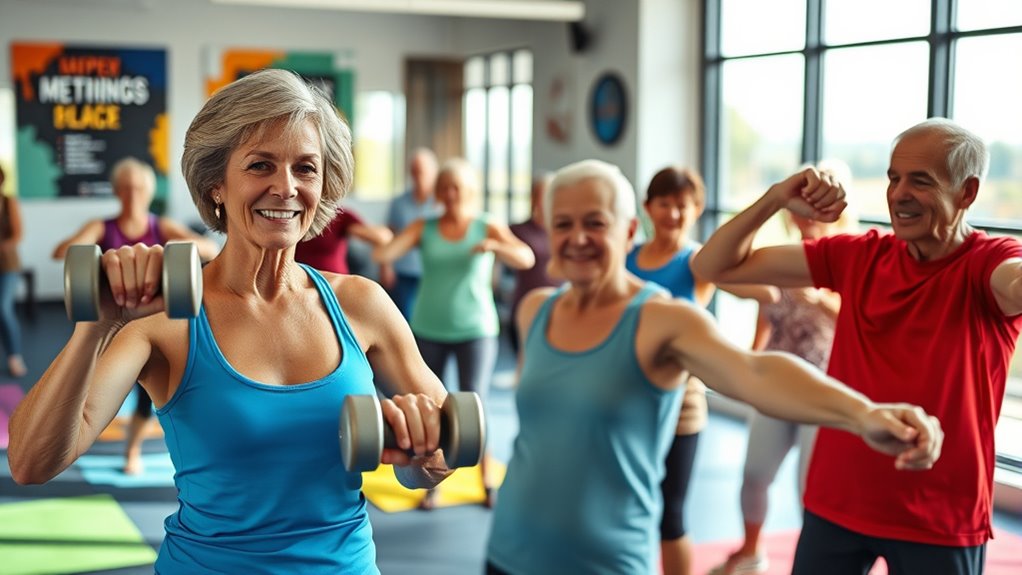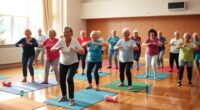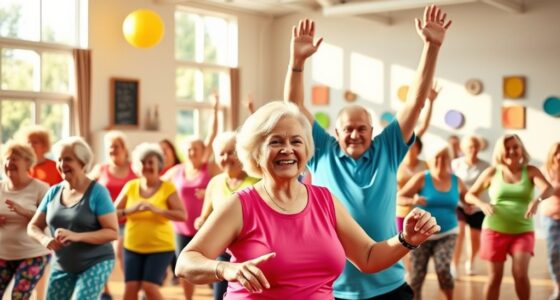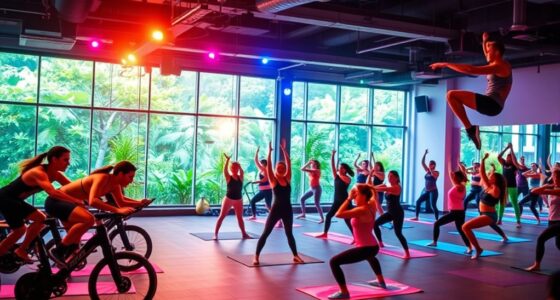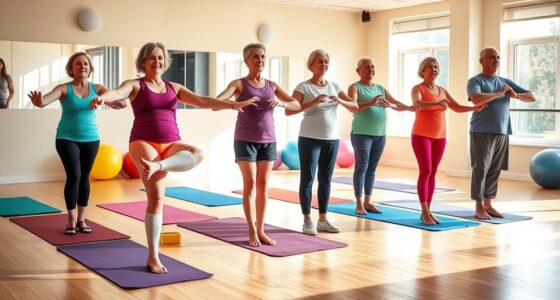Upper body workouts are essential for seniors looking to build strength quickly. They enhance independence, improve daily task performance, and counteract muscle loss that starts around age 40. Focus on exercises like dumbbell chest presses, seated rows, and bicep curls to promote muscle growth and joint health. It’s important to prioritize safety with proper form and modifications. By incorporating a consistent routine, you can boost motivation and see rapid results. You’ll discover even more beneficial tips to enrich your fitness journey.
Key Takeaways
- Incorporate resistance training exercises like dumbbell chest presses and seated rows to effectively build upper body strength.
- Use light weights (3 to 8 pounds) for bicep curls and tricep extensions to focus on control and prevent strain.
- Modify exercises, such as wall push-ups, to reduce joint stress while still engaging upper body muscles.
- Track your progress by recording weights, repetitions, and sets to maintain motivation and measure strength gains.
- Join group exercise classes to enhance accountability and make strength training enjoyable for seniors.
The Importance of Upper Body Strength for Seniors
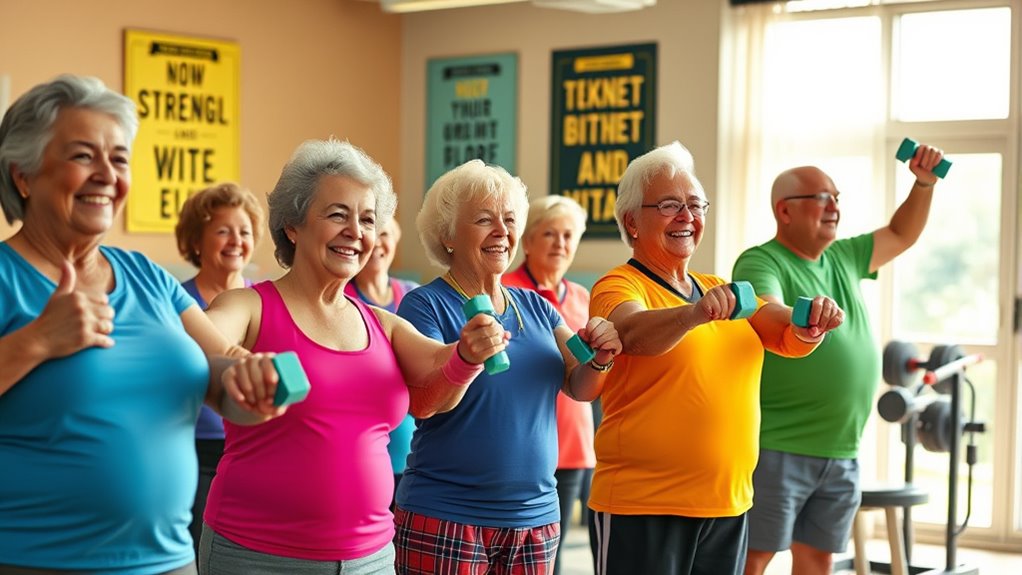
As you age, maintaining upper body strength becomes essential for your daily life. For older adults, strong upper-body muscles are critical for performing tasks like lifting groceries and reaching high shelves, promoting independence and mobility. Additionally, emotional and psychological growth plays a role in maintaining motivation for physical activity and strength training. Regular physical activity can also help mitigate brain fog symptoms, which are often associated with cognitive decline in older adults. Engaging in effective co-parenting plans can also contribute to a supportive environment, encouraging seniors to stay active. Moreover, support resources available for caregivers can help create a positive atmosphere that promotes physical activity among seniors.
Unfortunately, muscle mass decline, known as sarcopenia, can start around age 40, leading to significant muscle loss by age 80. This makes strength training crucial for maintaining functionality and quality of life. Regular resistance training helps build and maintain upper body strength, counteracting the effects of sarcopenia.
Additionally, improved upper body strength contributes to better posture and balance, reducing the risk of falls and injuries. Ultimately, focusing on upper body workouts enhances your overall health and well-being, allowing you to enjoy an active lifestyle. Moreover, engaging in renewable energy sources can provide sustainable solutions to support your fitness routine while promoting a healthier lifestyle.
Benefits of Resistance Training
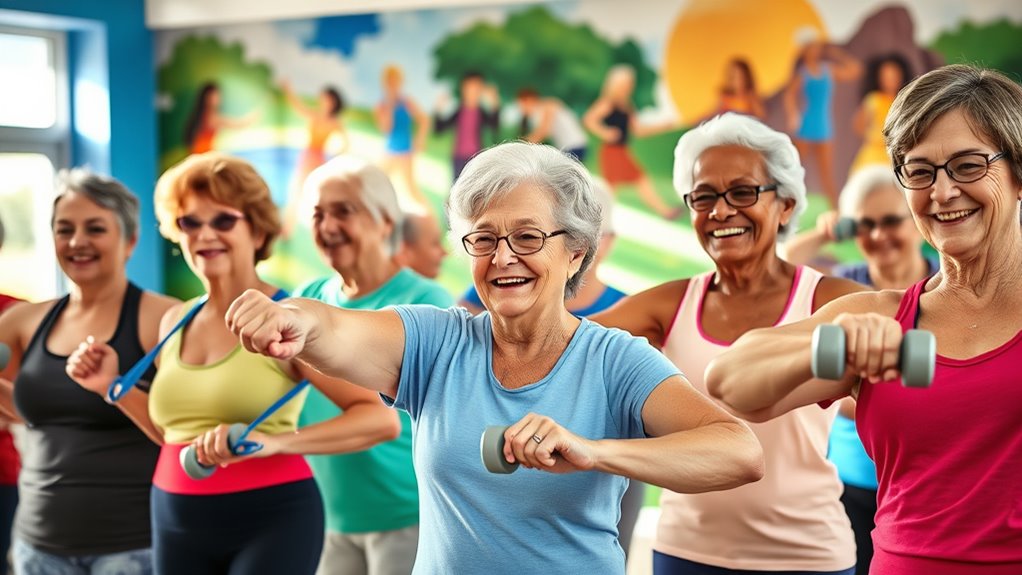
Resistance training offers you enhanced muscle growth and improved joint health, making everyday tasks easier and safer. By building strength, you can increase your functional independence, allowing you to enjoy life more fully. Incorporating these exercises into your routine can greatly elevate your overall well-being. Additionally, regular strength training can improve mental clarity and support your cognitive function as you age. Engaging in mindfulness practices during workouts can further enhance self-awareness and focus, contributing to a more fulfilling exercise experience. This practice aligns with the principles of holistic wellness that Comfort a Life promotes, helping you to nurture both your body and mind. Moreover, as you build strength, you may experience a greater sense of emotional well-being, further enriching your overall quality of life. Regular resistance training can also lead to improved joint health, which is crucial for maintaining mobility as you age.
Enhanced Muscle Growth
When you engage in resistance training, you’re not just building strength; you’re also enhancing your overall upper-body function. This type of training is vital for older adults looking to maintain or even increase muscle mass. Additionally, nutrition plays a crucial role in supporting muscle growth and recovery.
With just 16 sessions of focused upper body workouts, you can experience significant gains in strength. Resistance training helps counteract sarcopenia, ensuring you keep your muscle mass as you age. Additionally, regular participation in resistance training can lead to improved nutrient circulation, which supports healthy muscle tissues and joints. Research has shown that predictive analytics can help tailor training programs to individual needs for maximum effectiveness. Furthermore, the use of advanced sensors in workout tracking can provide valuable feedback on your training progress.
Plus, it improves nutrient circulation, which supports healthy muscle tissues and joints. As a bonus, regular strength training enhances your balance, coordination, and mobility, reducing your risk of falls and injuries. Additionally, incorporating educational toys into your routine can stimulate cognitive growth, further supporting your overall well-being as you age.
Improved Joint Health
While many may think of resistance training solely for building strength, it also plays a crucial role in improving joint health. By strengthening the muscles surrounding your joints, resistance training provides better support and stability during movement. Regular outings to parks for puppy socialization can also be beneficial for overall physical activity, promoting movement and exercise.
Enhanced muscle strength leads to improved joint flexibility and mobility, reducing your risk of stiffness and injury. Regular resistance training can also mitigate age-related joint degeneration, potentially decreasing the likelihood of conditions like osteoarthritis. Additionally, engaging in architectural solutions can create innovative spaces for seniors to exercise comfortably and safely. Furthermore, incorporating a retirement savings plan can help ensure that seniors have the financial resources to engage in regular fitness activities. Research indicates that regular exercise can significantly enhance joint health and functionality.
Studies show that even moderate resistance exercises can greatly improve joint function and reduce pain for older adults facing chronic joint issues. By fostering stronger muscles and connective tissues, resistance training contributes to your overall joint health, which is essential for maintaining your independence in daily activities. Additionally, incorporating educational and skill-building toys can further enhance physical activity and engagement for seniors during their workouts.
Increased Functional Independence
Functional independence is essential for seniors to maintain a fulfilling lifestyle, and strength training plays a key role in achieving that.
By focusing on resistance training, you can greatly enhance your upper body strength, making daily tasks like lifting, reaching, and carrying much easier.
Studies show that just 16 sessions can lead to substantial gains in muscle strength, increasing your mobility and reducing reliance on assistance.
This improved strength also promotes better posture and balance, lowering your risk of falls—an important concern for maintaining independence.
Additionally, enhanced upper body strength supports joint health, allowing you to engage more actively in social and physical activities that contribute to your overall well-being and quality of life.
Top Upper Body Exercises for Seniors
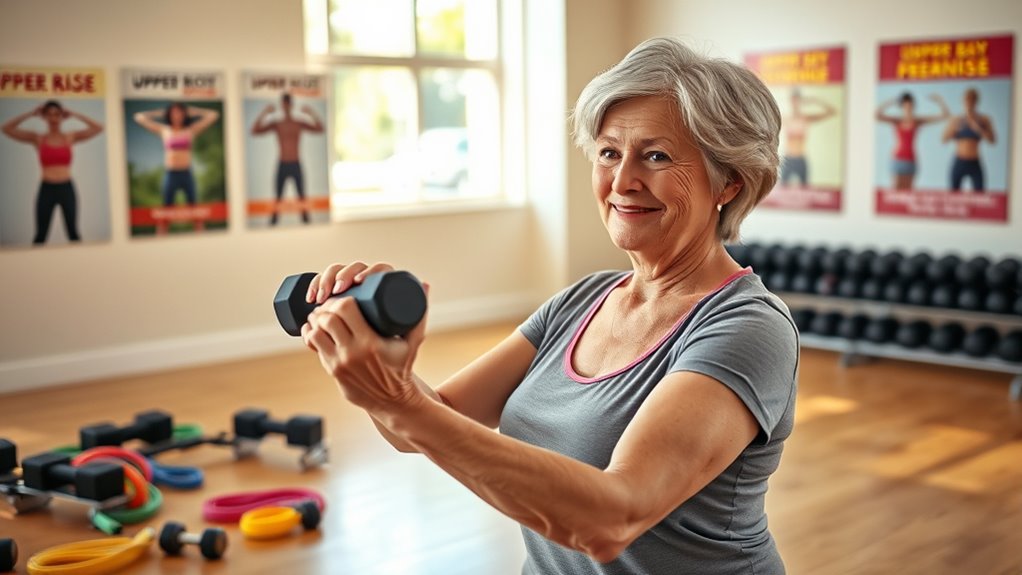
When it comes to upper body workouts, knowing which exercises to focus on can make all the difference.
You’ll want to explore essential strength-building exercises, safe modifications that suit your needs, and tips for tracking your progress. Additionally, incorporating air quality improvements through cleaner indoor environments can significantly enhance your overall well-being and motivation during workouts.
These elements will help you stay motivated and achieve your fitness goals.
Essential Strength-Building Exercises
Building upper body strength is essential for seniors, as it enhances your ability to perform daily tasks with ease. Incorporate exercises like the dumbbell chest press to target your chest, shoulders, and triceps, improving overall upper body strength.
Seated rows are perfect for strengthening your mid-back and biceps while being gentle on your joints. Don’t forget the dumbbell shoulder press, which boosts your ability to reach overhead—important for maintaining independence.
Lat pulldowns also play a critical role in spinal stabilization, enhancing mobility. Finally, add bicep curls and tricep extensions to build arm strength, making lifting and stabilizing during various functional movements easier.
These exercises will help you stay strong and active!
Safe Exercise Modifications
To guarantee you can safely enjoy upper body workouts, it’s essential to incorporate modifications that cater to your needs.
For instance, try doing push-ups against a wall or countertop to reduce strain on your joints while still engaging your chest and arms effectively. The floor press is another safe exercise modification, allowing you to strengthen your upper body while minimizing shoulder strain.
Use light weights, like 3 to 8 pounds, for bicep curls and tricep extensions, focusing on controlled movements to enhance strength. Adapt seated rows with resistance bands for a low-impact option.
Finally, perform arm circles with or without light weights to improve shoulder mobility and strength, making these exercises accessible for all fitness levels.
Progress Tracking Tips
How can you effectively track your progress in upper body workouts? Start by monitoring repetitions and sets weekly, aiming for gradual increases. Use a workout journal to record weights for exercises like dumbbell chest presses or bicep curls, as this helps you see strength gains over time. Regularly assess specific exercises, like push-ups or tricep dips, to keep motivation high. Setting realistic goals guarantees you have clear targets to aim for, whether it’s lifting heavier weights or completing more reps.
| Progress Tracking Tips | Actions to Take |
|---|---|
| Monitor Repetitions | Track weekly exercise completions |
| Record Weights | Document weights used for lifts |
| Keep a Workout Journal | Note feelings of fatigue/soreness |
| Set Realistic Goals | Define short and long-term targets |
Safety Considerations When Exercising

When you engage in upper body workouts, prioritizing safety is essential to guarantee a positive and effective exercise experience. Keep these safety considerations in mind:
- Warm-up: Always start with a thorough warm-up to prepare your muscles and joints, reducing the risk of injury.
- Proper form: Maintain proper form throughout each exercise to prevent strains, especially in vulnerable areas like your shoulders and wrists.
- Listen to your body: If you experience pain, stop exercising. This could indicate the need for modifications or alternative exercises.
Don’t forget to consult with a healthcare professional before starting any new exercise program, particularly if you have existing health concerns.
Finally, incorporate a cool-down period after workouts to help your muscles recover and reduce soreness.
Getting Started With Upper Body Workouts
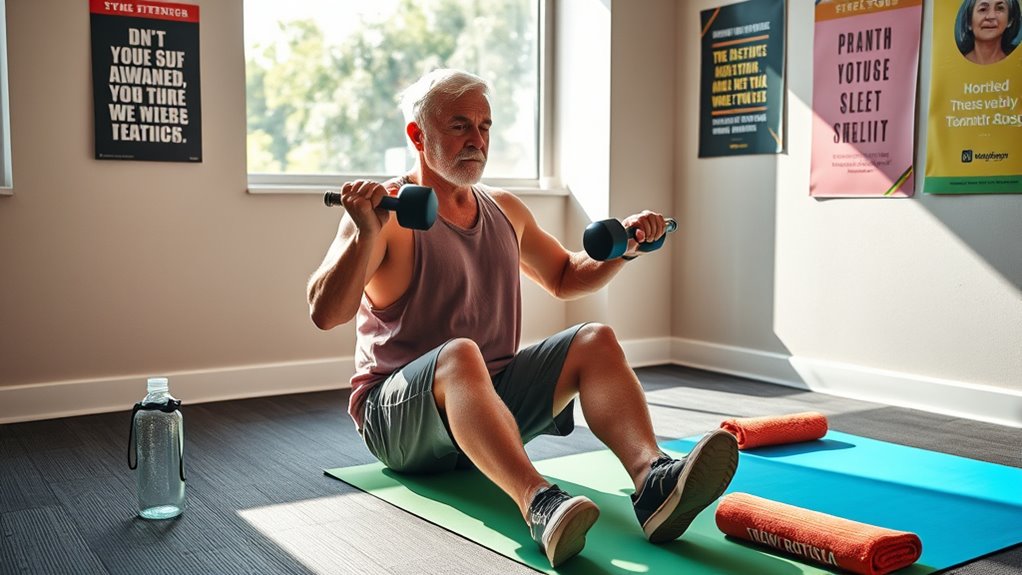
Starting upper body workouts can feel intimidating, but with the right approach, you can build strength and confidence safely.
Begin in a comfortable starting position, using light weights to reduce any strain. Focus on exercises like modified push-ups or seated rows, guaranteeing your upper arms are parallel to the ground. As you lift, maintain control and slowly lower the dumbbells to avoid injury.
Gradual progression is key—start with a few repetitions and gradually increase as you feel more comfortable. Aim for resistance training at least twice a week to enhance muscle strength and mobility.
Always consult with a healthcare professional before starting to guarantee your routine is safe and suitable for your individual health needs.
Tips for Staying Motivated and Consistent
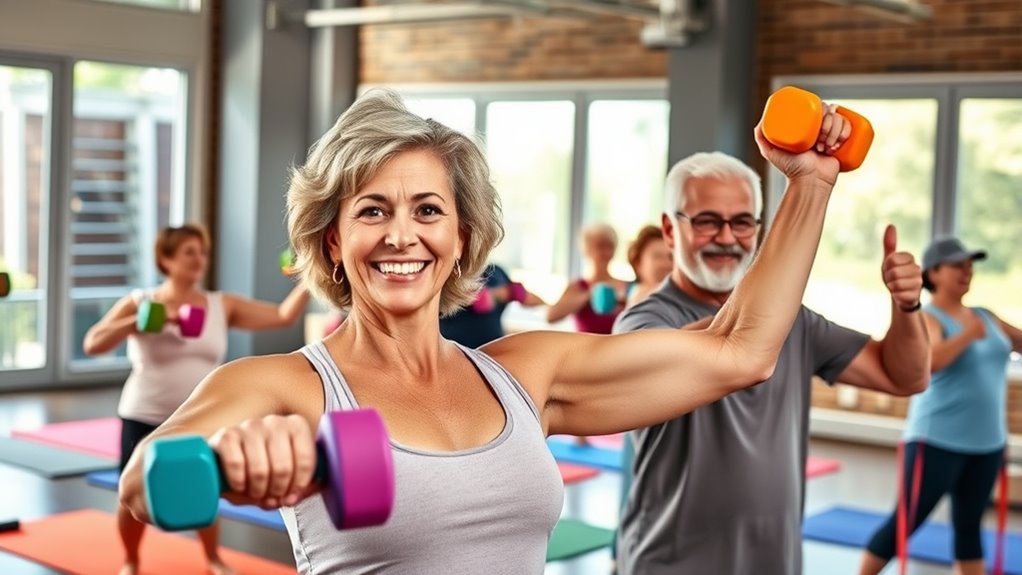
Staying motivated and consistent with upper body workouts can feel like climbing a mountain, but with the right strategies, you can reach your goals. Here are some tips to help you stay on track:
Staying motivated for upper body workouts can be challenging, but with effective strategies, you can achieve your fitness goals.
- Set realistic and achievable fitness goals: Break your larger goals into smaller milestones to keep motivation high and track progress effectively.
- Establish a regular workout routine: Schedule your sessions at the same time each week to create a habit that sticks.
- Participate in group exercises: Join a class or find a workout buddy. This fosters accountability and makes exercising more enjoyable.
Don’t forget to celebrate milestones, no matter how small, as they’ll boost your confidence and keep you committed to your strength-building journey!
Frequently Asked Questions
How to Build up Strength in the Elderly?
To build strength in the elderly, you should encourage regular resistance training.
Start with simple exercises that focus on major muscle groups, like seated rows or modified push-ups. Aim for at least two sessions a week, gradually increasing intensity as comfort grows.
Incorporating flexibility and balance exercises can also enhance overall stability and mobility.
Always listen to your body, and consult a healthcare professional if you have any concerns or limitations.
How to Build an Upper Body Exercise Plan for Over 60?
To build an upper body exercise plan for those over 60, start by incorporating resistance training with exercises like dumbbell chest presses and bicep curls.
Aim for two non-consecutive days of exercise each week. Begin with light weights or bodyweight movements, focusing on proper form.
Include a variety of exercises to target different muscle groups, and don’t forget to warm up and cool down.
Listen to your body, and track your progress to stay motivated.
How Many Times a Week Should a 70 Year Old Lift Weights?
If you’re 70, aim to lift weights at least two to three times a week.
This frequency helps you build and maintain muscle strength effectively.
Focus on major muscle groups and consider doing one or two sets of 6 to 12 repetitions per session.
Remember to include rest days between workouts to allow your body to recover.
Always consult with a healthcare provider before starting any weightlifting program for tailored safety and effectiveness.
How Do You Build Upper Body Strength When Weak?
To build upper body strength when you feel weak, start with resistance bands or light dumbbells.
Focus on simple movements like bicep curls and tricep extensions. Gradually increase the weight as you gain confidence.
Incorporate compound exercises like wall push-ups or seated rows to engage multiple muscles at once.
Aim for two nonconsecutive workout days a week, tracking your progress to stay motivated.
With patience and consistency, you’ll see improvements over time.
Conclusion
Incorporating upper body workouts into your routine can be like planting seeds for a stronger future. As you build strength, you’ll not only improve your physical health but also boost your confidence and independence. Remember, consistency is key—just like nurturing those seeds until they bloom. So, lace up your sneakers, grab some resistance bands, and start today. You’re on the path to a healthier, stronger you, and every rep counts towards your growth!
